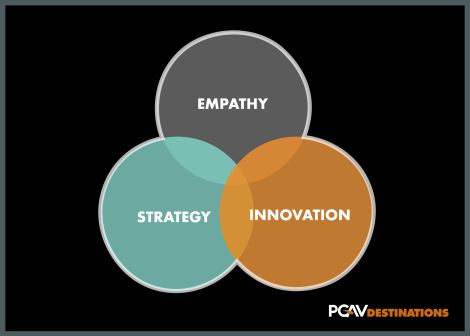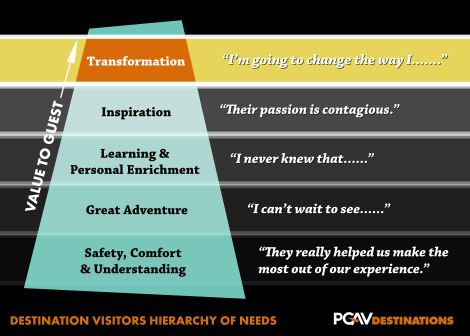Empathy, Inc.
– By Mike Konzen, principal and chair
What is the fundamental value that drives your business?
A few years back, my partner Jim Moorkamp and I developed a description of PGAV Destinations’ practice based on three elements: Empathy, Strategy, and Innovation (ESI). We used a Venn Diagram (below) to describe the interrelated nature of these three. As time has passed, ESI still seems very relevant to me.
But more and more, empathy seems to stand out as the most important element. I believe that it is the fundamental value that drives our practice.
Why is this? Strategy and innovation are important concepts, to be sure. But I think that empathy represents the culture and mission of our organization. And I believe that it is expressed in two fundamental ways: Professional and Personal Empathy.
Professional empathy comes from a deep sense of concern and regard for our clients. Their goals are our goals. Their challenges are our challenges. In truth, our practice has grown organically through the years to serve the needs of our clients, and the result has been our relatively unique mix of creative professionals and services. In describing his medical practice, our client Dr. George Bilbry once said:
“The essence of a professional is to put the needs of your clients before your own needs.”
Even in an industry with some prominent egos, I’d like to think that we succeed based on professional empathy. It really is good for business. For us to truly succeed, our clients must succeed.
But at a deeper level, we experience and practice empathy in a very personal way. This is predominantly represented in a deep caring for the needs of the guests at our destinations. What are they seeking? What do they want for themselves and their families? How can our work enrich their lives in meaningful, enduring ways?
Research has shown that human beings have limbic brains that are uniquely suited to incorporating empathy into our creative processes. In their essay “Empathy on the Edge,” Katja Battarbee, Jane Fulton Suri, and Suzanne Gibs Howard of IDEO describe the use of empathy in design as an “out of ego” experience. Empathetic designers must set aside their own agendas, expertise, or desire for status in order to grasp the truth of what our visitors really want. In doing this, we often learn something meaningful about ourselves.
We try to deepen our understanding of destination guests by making significant investments in visitor research on a wide variety of topics. We published ten nationwide studies in recent years. There seems to be an almost endless array of subjects; and of course the more we research, the better we understand the limits of our real knowledge of the visitor.
Beyond formal primary research, we benefit from placing ourselves in the “space” of the visitor, sharing their challenges and observing their reactions. Many of our best breakthrough ideas come from this level of intense, empathetic observation.
When I visit our destinations and really pay close attention to visitors, I am usually reminded that our work can go well beyond merely entertaining them. I believe that our work can fundamentally transform people: change the way they see themselves, their lives, or perhaps their place in the world. To express this concept, we have adapted a version of Maslow’s Hierarchy of Needs, shown below.
Just as Maslow places “self-actualization” at the top of his pyramid, we place “transformation” of the guest at the top of ours. And to help them achieve transformation, we must pay attention to their needs every step along the way. It’s pretty hard for guests to feel enriched and inspired when the lines are too long, the path confusing, and bathrooms too well hidden. We cannot expect them to feel enriched when the experience is not enriching and adventurous.
Can a successful design practice be based on principles of empathy? I absolutely believe that we demonstrate this every day. And, after fifty years in practice, we are still finding new ways to incorporate personal and professional empathy into our work.
Note: the title for this post was inspired by Creativity, Inc., by Ed Catmull, President of Pixar Animation and Disney Animation. I strongly recommend this book to anyone interested in Pixar’s remarkable story.





